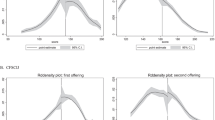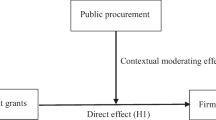Abstract
In this paper, we use plant level data on the start-up size of new plant entries and detailed information on the grants received by such plants in order to investigate whether grant receipt encourages plants to start-up with more employment than without support. The data relate to manufacturing plants in the Republic of Ireland, where industrial policy has a long history of using discretionary grants to encourage employment growth. We use a matching procedure to deal with the issue of selectivity into grant receipt and a quantile regression estimator to allow for different effects of grants on plants depending on their position in the start-up size distribution. Our results provide evidence that grants do indeed encourage plants to start-up larger. We also find that this effect is generally higher for foreign than for domestic plants and that it differs for plants at different quantiles of the start-up size distribution.



Similar content being viewed by others
Notes
Another important effect of such financial constraints may be that potentially viable businesses do not start up at all. Since the data used in this paper only cover plants that began to operate, addressing this issue is beyond the scope of the current paper.
Previous analyses of similar government assistance scheme generally focus on effects of assistance on plant survival, growth and productivity. See, for example, Girma et al. (2007a, b) for the Irish case as well as Harris and Robinson (2004) and Wren and Storey (2002) for evaluations of the British Regional Selective Assistance scheme.
Authors’ own calculation from the data set described in the paper in 1998 prices. Note that this includes payments made to firms before and inclusive of their year of start-up, i.e. their first year of positive employment.
See Meyler and Strobl (2000) for details.
While regional concerns still dominated in the 1970s, by the early 1980s, a strategic industry approach, encouraging the attraction of multinationals and the development of an indigenous sector in technology intensive sectors, became the primary concern. Nevertheless, regions always remained of at least some concern.
In the very early years, grant provision was under the authority of the Underdeveloped Areas Board before this responsibility was taken over by the IDA.
After 1998, Forbairt became Enterprise Ireland as a consequence of a merger with the Irish Trade board.
While, arguably, plants with lower foreign ownership should still possibly be considered to be foreign owned, this is not necessarily a problem for the case of Ireland, since almost all inward foreign direct investment has been greenfield investment rather than acquisition of local firms (see Barry and Bradley 1997).
For plants where the first year of employment does not fall within our sample period frame, we use information on the start-up year to determine the length of its existence.
Grants are generally given before start-up and not afterwards as we were assured in discussions with Forfás.
We did also experiment with using employment in the second year as an indicator of size, and results were not always similar to the results for first year employment in the sense that many previously significant coefficients on our grant measures were no longer significant. However, two aspects speak against this alternative measure. Firstly, nearly 10% of total start-ups had already closed down by the second year and thus needed to be dropped from the sample. Secondly, also many of our other explanatory variables were also no longer significant, suggesting that employment in the second year was not related to determinants of the actual start-up year.
More accurately, the level variable is defined as the natural log of the amount plus one in order to allow for zero grant receipts.
The manufacturing sector is broken down into 12 sub-sectors: Non-Metallic Minerals, Chemicals, Metals & Engineering, Food, Drink & Tobacco, Clothing & Footwear, Textiles, Wood Products, Paper Products & Printing, Peat and other Mineral Extraction and Other Manufacturing.
The matching is performed in Stata Version 7 using the software provided by Sianesi (2001).
Additionally quantile methods provide a more robust and efficient alternative to least squares estimators when the error term is non-normal. As can be seen from Fig. 1, this may be an important feature of our data as (logged) plant level start-up size does not appear to be (log) normally distributed. This is further confirmed for both groups using the Shapiro–Wilk test, which decisively rejected normality of the data.
Our choice of the lowest quantile, i.e. 0.20, was dictated by the nature of our data set. For quantiles lower than this, the lack of variation in start-up size meant that adequate convergence using maximum likelihood methods could not be reached.
One should note that matching does not necessarily have to be restricted to one type of matching.
Harrison and McMillan (2003) have recently provided evidence that in Cote d’Ivoire, only domestic firms face financial constraints. This is intuitively plausible, as foreign firms have many means of financing their operations, not least foreign direct investment, i.e. capital transfers from the parent company. Hence, they are less likely to be reliant on the domestic capital market.
We set grant amounts of zero equal to one in order to ensure their inclusion once we transformed the variable into its natural logarithm.
References
Agarwal R, Audretsch D (2001) Does entry size matter? The impact of the life cycle and technology on firm survival. J Ind Econ 49:21–43
Almus M, Czarnitzki D (2003) The effects of public R&D subsidies on firms' innovation activities: the case of Eastern Germany. J Bus Econ Stat 21:132–145
Barry F, Bradley J (1997) FDI and trade: the Irish host-country experience. Econ J 107:1798–1811
Beason R, Weinstein DE (1996) Growth, economies of scale, and targeting in Japan (1955–1990). Rev Econ Stat 78:286–295
Beesley ME, Hamilton RE (1984) Small firms' seedbed role and the concept of turbulence. J Ind Econ 33:217–231
Cabral LMB, Mata J (2003) On the evolution of the firm size distribution: facts and theory. Am Econ Rev 93:1075–1090
Confederation of British Industry (CBI) (2000) Annual report. Confederation of British Industry, London
Cowling, M, Clay, N (1995) Factors influencing take-up rates on the loan guarantee ccheme. Small Bus Econ 7: 141–152
Dehejia RH, Wahba S (2002) Propensity score matching methods for nonexperimental causal studies. Rev Econ Stat 84:151–161
Diamond A (2005) Reliable estimation of average and quantile causal effects in a non-experimental setting. http://www.people.fas.harvard.edu/~rtmoore/GMMC/Quantile.pdf
Dunne T, Roberts M, Samuelson L (1989) The growth and failure of U. S. manufacturing plants. Q J Econ 104:671–698
Evans D (1987) Tests of alternative theories of firm growth. J Polit Econ 95:657–674
Girma S, Greenaway D, Wakelin K (2001) Who benefits from foreign direct investment in the UK? Scott J Polit Econ 48:119–133
Girma S, Görg H, Strobl E (2007a) The effect of government grants on plant level productivity. Econ Lett 94:439–444
Girma S, Görg H, Strobl E (2007b) The effect of government grants on plant survival: a micro-econometric analysis. Int J Ind Organ 25:701–720
Grahl J, Teague P (2004) The German model in danger. Ind Relat J 35:557–573
Görg H, Strobl E (2001) Multinational companies and entrant start-up size: evidence from quantile regressions. Rev Ind Organ 20:15–31
Greenwald B, Stiglitz J, Weiss A (1984) Information imperfections in the capital market and macroeconomic fluctuations. American Economic Review Papers and Proceedings 74:194–199
Harrison AE, McMillan MS (2003) Does direct foreign investment affect domestic credit constraints. J Int Econ 61:73–100
Heckman J, Ichimura H, Smith J, Todd P (1997) Matching as an econometric evaluation estimator: evidence from evaluating a job training programme. Rev Econ Stud 64:605–654
Harris R, Robinson C (2004) Industrial policy in Great Britain and its effect on total factor productivity in manufacturing plants, 1990–1998. Scott J Polit Econ 51:528–543
Helpman E, Melitz MJ, Yeaple SR (2004) Export versus FDI with heterogeneous firms. Am Econ Rev 94:300–316
Holmes TJ, Stevens JJ (2002) Geographic concentration and establishment scale. Rev Econ Stat 84:682–690
Honohan P (1998) Key issue of cost-benefit methodology for Irish industrial policy, general research series no. 172. Economic and Social Research Institute, Dublin
Jovanovic B (1982) Selection and evolution of industry. Econometrica 50:649–670
Koenker R, Bassett G (1978) Regression quantiles. Econometrica 46:33–50
Lechner M (2002) Some practical issues in the evaluation of heterogenous labour market programmes by matching methods. J R Stat Soc 165:59–82
Lerner J (1999) The Government as venture capitalist: the long-run impact of the SBIR programme. J Bus 72:285–318
Mata J, Machado JAE (1996) Firm start-up size: a conditional quantile approach. Eur Econ Rev 40:1305–1323
Maung, N A, Erens, R (1991) Enterprise allowance scheme: a survey of participants two years after leaving. Social and Country Planning Research, London
Meyler A, Strobl E (2000) Regional industrial policy and job generation in Ireland. Econ Soc Rev 31:111–128
Rosenbaum P, Rubin DB (1983) The central role of the propensity score in observational studies for causal effects. Biometrika 70:41–55
Ruane F, Görg H (1996) Aspects of foreign direct investment in Irish manufacturing since 1973: policy and performance. J Stat Soc Inq Soc Irel 27:37–85
Sianesi, Barbara (2001) Implementing propensity score matching estimators with Stata. Program available at http://fmwww.bc.edu/RePEc/usug2001/psmatch.pdf
Stiglitz J, Weiss A (1981) Credit rationing in markets with incomplete information. Am Econ Rev 71:393–409
Storey D (1994) 1994. Understanding the small business sector, Routledge
Sutton J (1991) Sunk costs and market structure. MIT, Cambridge
Wallsten SJ (2000) The effects of government-industry R&D programs on private R&D: the case of the small business innovation research program. Rand J Econ 31:82–100
Wren C, Storey DJ (2002) Evaluating the effect of soft business support upon small firm performance. Oxf Econ Pap 54:335–365
Author information
Authors and Affiliations
Corresponding author
Additional information
We are grateful to Forfás for the provision of the data and to two double-blind peer reviewers and the editor, Hamid Etemad, for very helpful comments on an earlier draft.
Rights and permissions
About this article
Cite this article
Girma, S., Görg, H., Hanley, A. et al. The effect of grant receipt on start-up size: Evidence from plant level data. J Int Entrep 8, 371–391 (2010). https://doi.org/10.1007/s10843-010-0061-y
Published:
Issue Date:
DOI: https://doi.org/10.1007/s10843-010-0061-y




